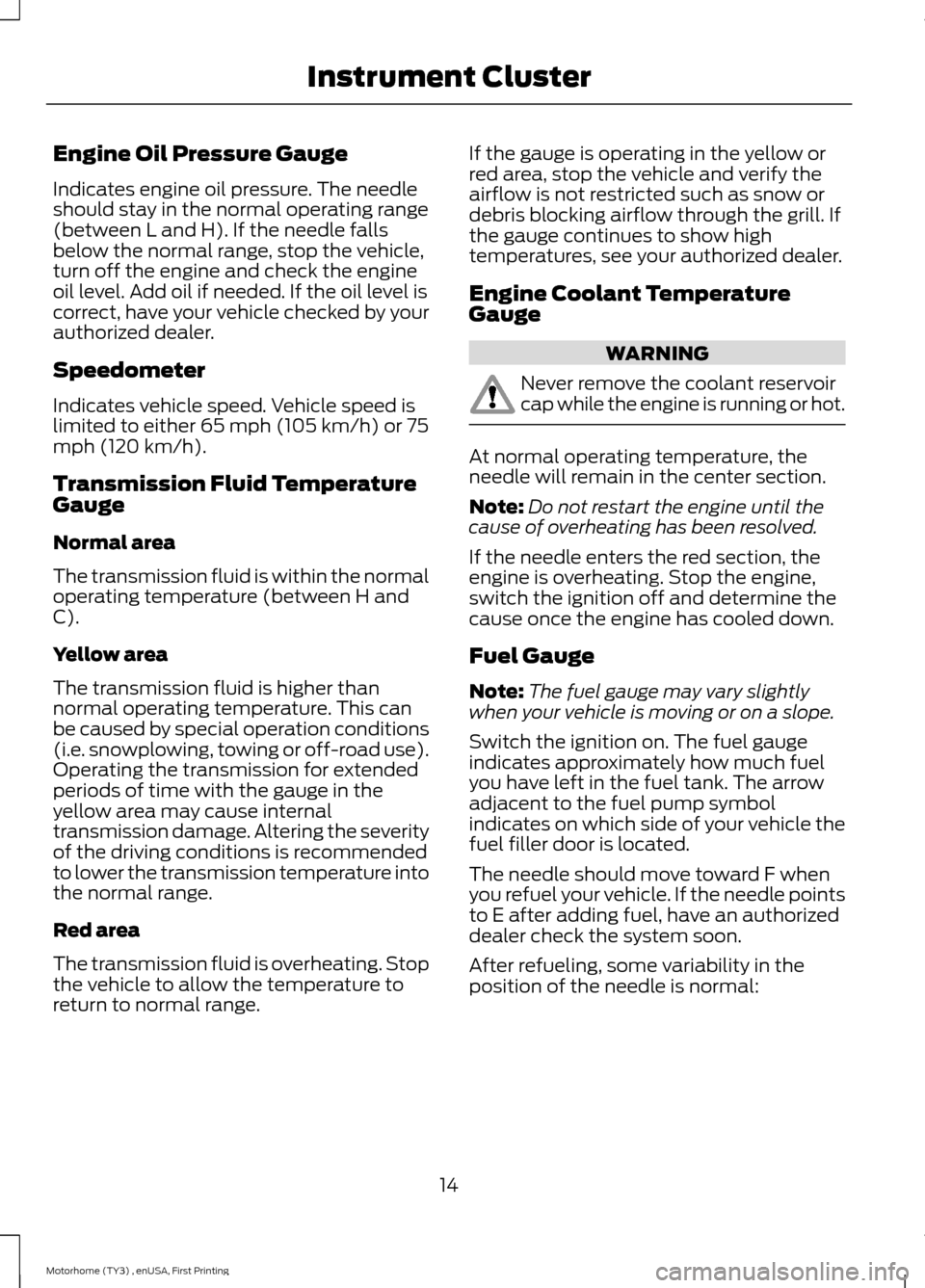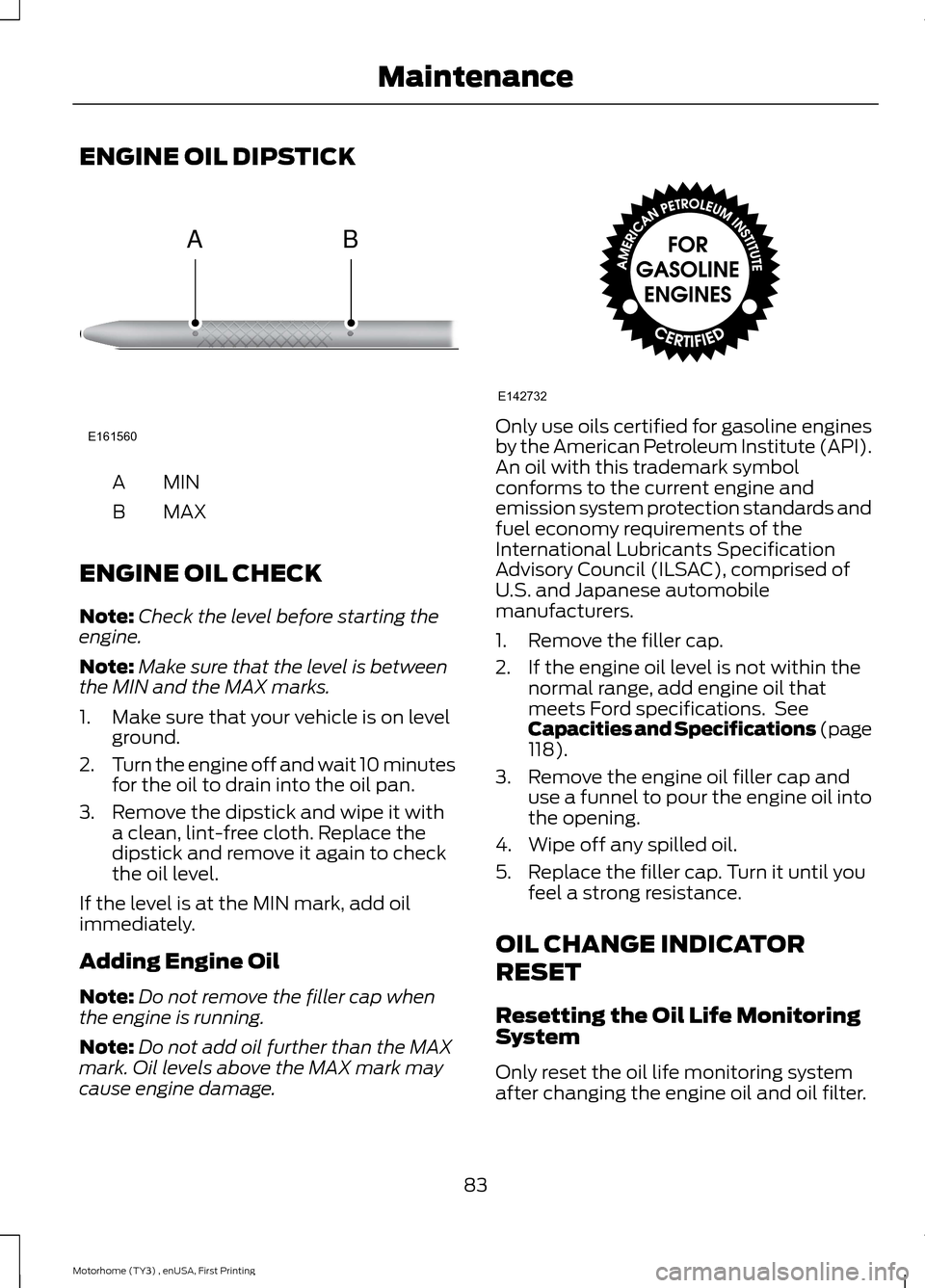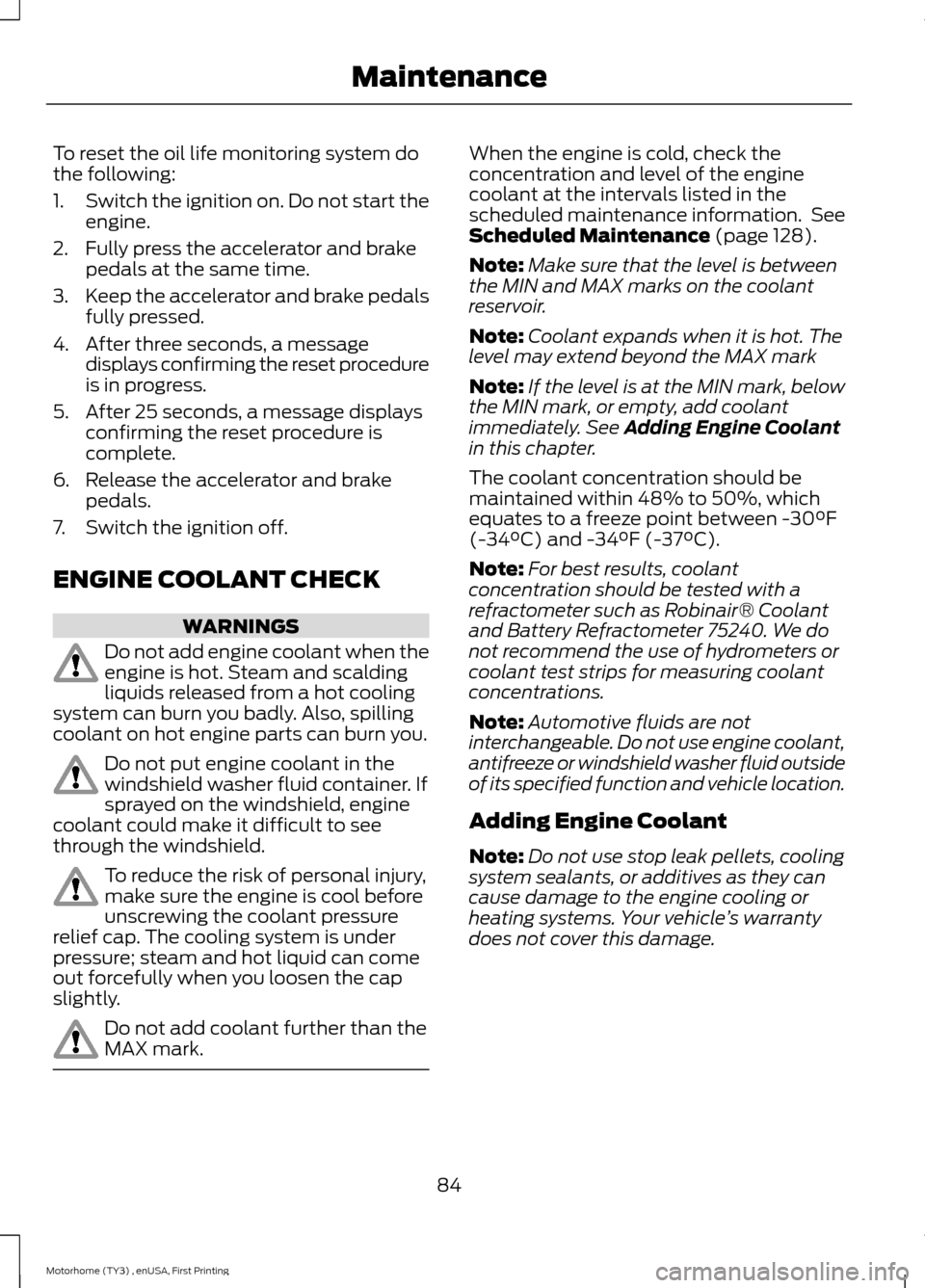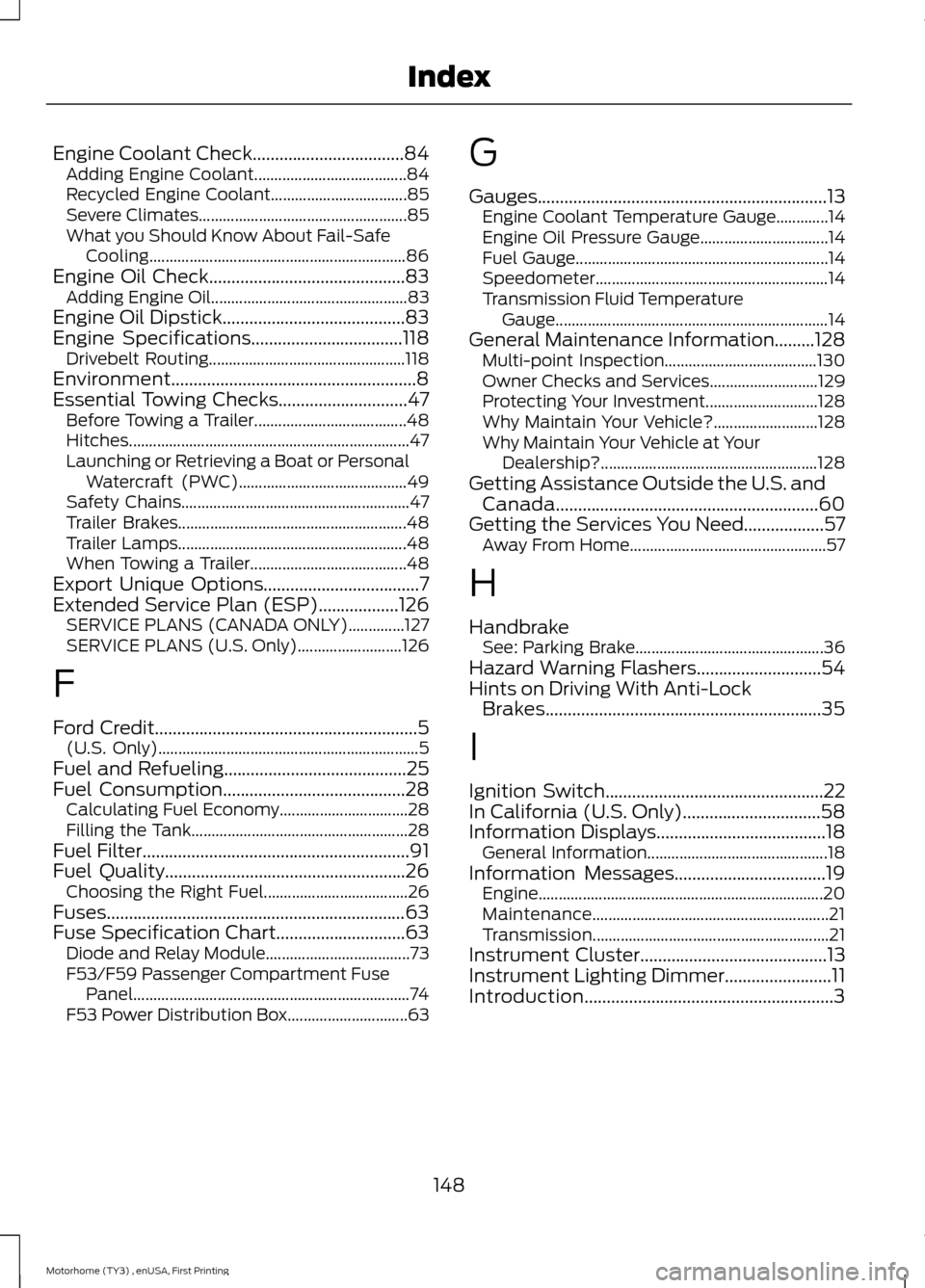2016 FORD F SERIES MOTORHOME AND COMMERCIAL CHASSIS adding oil
[x] Cancel search: adding oilPage 17 of 154

Engine Oil Pressure Gauge
Indicates engine oil pressure. The needleshould stay in the normal operating range(between L and H). If the needle fallsbelow the normal range, stop the vehicle,turn off the engine and check the engineoil level. Add oil if needed. If the oil level iscorrect, have your vehicle checked by yourauthorized dealer.
Speedometer
Indicates vehicle speed. Vehicle speed islimited to either 65 mph (105 km/h) or 75mph (120 km/h).
Transmission Fluid TemperatureGauge
Normal area
The transmission fluid is within the normaloperating temperature (between H andC).
Yellow area
The transmission fluid is higher thannormal operating temperature. This canbe caused by special operation conditions(i.e. snowplowing, towing or off-road use).Operating the transmission for extendedperiods of time with the gauge in theyellow area may cause internaltransmission damage. Altering the severityof the driving conditions is recommendedto lower the transmission temperature intothe normal range.
Red area
The transmission fluid is overheating. Stopthe vehicle to allow the temperature toreturn to normal range.
If the gauge is operating in the yellow orred area, stop the vehicle and verify theairflow is not restricted such as snow ordebris blocking airflow through the grill. Ifthe gauge continues to show hightemperatures, see your authorized dealer.
Engine Coolant TemperatureGauge
WARNING
Never remove the coolant reservoircap while the engine is running or hot.
At normal operating temperature, theneedle will remain in the center section.
Note:Do not restart the engine until thecause of overheating has been resolved.
If the needle enters the red section, theengine is overheating. Stop the engine,switch the ignition off and determine thecause once the engine has cooled down.
Fuel Gauge
Note:The fuel gauge may vary slightlywhen your vehicle is moving or on a slope.
Switch the ignition on. The fuel gaugeindicates approximately how much fuelyou have left in the fuel tank. The arrowadjacent to the fuel pump symbolindicates on which side of your vehicle thefuel filler door is located.
The needle should move toward F whenyou refuel your vehicle. If the needle pointsto E after adding fuel, have an authorizeddealer check the system soon.
After refueling, some variability in theposition of the needle is normal:
14Motorhome (TY3) , enUSA, First PrintingInstrument Cluster
Page 86 of 154

ENGINE OIL DIPSTICK
MINA
MAXB
ENGINE OIL CHECK
Note:Check the level before starting theengine.
Note:Make sure that the level is betweenthe MIN and the MAX marks.
1.Make sure that your vehicle is on levelground.
2.Turn the engine off and wait 10 minutesfor the oil to drain into the oil pan.
3.Remove the dipstick and wipe it witha clean, lint-free cloth. Replace thedipstick and remove it again to checkthe oil level.
If the level is at the MIN mark, add oilimmediately.
Adding Engine Oil
Note:Do not remove the filler cap whenthe engine is running.
Note:Do not add oil further than the MAXmark. Oil levels above the MAX mark maycause engine damage.
Only use oils certified for gasoline enginesby the American Petroleum Institute (API).An oil with this trademark symbolconforms to the current engine andemission system protection standards andfuel economy requirements of theInternational Lubricants SpecificationAdvisory Council (ILSAC), comprised ofU.S. and Japanese automobilemanufacturers.
1.Remove the filler cap.
2.If the engine oil level is not within thenormal range, add engine oil thatmeets Ford specifications. SeeCapacities and Specifications (page118).
3.Remove the engine oil filler cap anduse a funnel to pour the engine oil intothe opening.
4.Wipe off any spilled oil.
5.Replace the filler cap. Turn it until youfeel a strong resistance.
OIL CHANGE INDICATOR
RESET
Resetting the Oil Life MonitoringSystem
Only reset the oil life monitoring systemafter changing the engine oil and oil filter.
83Motorhome (TY3) , enUSA, First PrintingMaintenanceE161560AB E142732
Page 87 of 154

To reset the oil life monitoring system dothe following:
1.Switch the ignition on. Do not start theengine.
2.Fully press the accelerator and brakepedals at the same time.
3.Keep the accelerator and brake pedalsfully pressed.
4.After three seconds, a messagedisplays confirming the reset procedureis in progress.
5.After 25 seconds, a message displaysconfirming the reset procedure iscomplete.
6.Release the accelerator and brakepedals.
7.Switch the ignition off.
ENGINE COOLANT CHECK
WARNINGS
Do not add engine coolant when theengine is hot. Steam and scaldingliquids released from a hot coolingsystem can burn you badly. Also, spillingcoolant on hot engine parts can burn you.
Do not put engine coolant in thewindshield washer fluid container. Ifsprayed on the windshield, enginecoolant could make it difficult to seethrough the windshield.
To reduce the risk of personal injury,make sure the engine is cool beforeunscrewing the coolant pressurerelief cap. The cooling system is underpressure; steam and hot liquid can comeout forcefully when you loosen the capslightly.
Do not add coolant further than theMAX mark.
When the engine is cold, check theconcentration and level of the enginecoolant at the intervals listed in thescheduled maintenance information. SeeScheduled Maintenance (page 128).
Note:Make sure that the level is betweenthe MIN and MAX marks on the coolantreservoir.
Note:Coolant expands when it is hot. Thelevel may extend beyond the MAX mark
Note:If the level is at the MIN mark, belowthe MIN mark, or empty, add coolantimmediately. See Adding Engine Coolantin this chapter.
The coolant concentration should bemaintained within 48% to 50%, whichequates to a freeze point between -30°F(-34°C) and -34°F (-37°C).
Note:For best results, coolantconcentration should be tested with arefractometer such as Robinair® Coolantand Battery Refractometer 75240. We donot recommend the use of hydrometers orcoolant test strips for measuring coolantconcentrations.
Note:Automotive fluids are notinterchangeable. Do not use engine coolant,antifreeze or windshield washer fluid outsideof its specified function and vehicle location.
Adding Engine Coolant
Note:Do not use stop leak pellets, coolingsystem sealants, or additives as they cancause damage to the engine cooling orheating systems. Your vehicle’s warrantydoes not cover this damage.
84Motorhome (TY3) , enUSA, First PrintingMaintenance
Page 151 of 154

Engine Coolant Check..................................84Adding Engine Coolant......................................84Recycled Engine Coolant..................................85Severe Climates....................................................85What you Should Know About Fail-SafeCooling................................................................86Engine Oil Check............................................83Adding Engine Oil.................................................83Engine Oil Dipstick.........................................83Engine Specifications..................................118Drivebelt Routing.................................................118Environment.......................................................8Essential Towing Checks.............................47Before Towing a Trailer......................................48Hitches......................................................................47Launching or Retrieving a Boat or PersonalWatercraft (PWC)..........................................49Safety Chains.........................................................47Trailer Brakes.........................................................48Trailer Lamps.........................................................48When Towing a Trailer.......................................48Export Unique Options...................................7Extended Service Plan (ESP)..................126SERVICE PLANS (CANADA ONLY)..............127SERVICE PLANS (U.S. Only)..........................126
F
Ford Credit...........................................................5(U.S. Only).................................................................5Fuel and Refueling.........................................25Fuel Consumption.........................................28Calculating Fuel Economy................................28Filling the Tank......................................................28Fuel Filter............................................................91Fuel Quality......................................................26Choosing the Right Fuel....................................26Fuses...................................................................63Fuse Specification Chart.............................63Diode and Relay Module....................................73F53/F59 Passenger Compartment FusePanel.....................................................................74F53 Power Distribution Box..............................63
G
Gauges.................................................................13Engine Coolant Temperature Gauge.............14Engine Oil Pressure Gauge................................14Fuel Gauge...............................................................14Speedometer..........................................................14Transmission Fluid TemperatureGauge....................................................................14General Maintenance Information.........128Multi-point Inspection......................................130Owner Checks and Services...........................129Protecting Your Investment............................128Why Maintain Your Vehicle?..........................128Why Maintain Your Vehicle at YourDealership?......................................................128Getting Assistance Outside the U.S. andCanada...........................................................60Getting the Services You Need..................57Away From Home.................................................57
H
HandbrakeSee: Parking Brake...............................................36Hazard Warning Flashers............................54Hints on Driving With Anti-LockBrakes..............................................................35
I
Ignition Switch.................................................22In California (U.S. Only)...............................58Information Displays......................................18General Information.............................................18Information Messages..................................19Engine.......................................................................20Maintenance...........................................................21Transmission...........................................................21Instrument Cluster..........................................13Instrument Lighting Dimmer........................11Introduction........................................................3
148Motorhome (TY3) , enUSA, First PrintingIndex